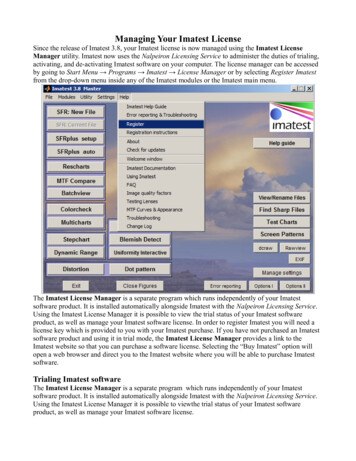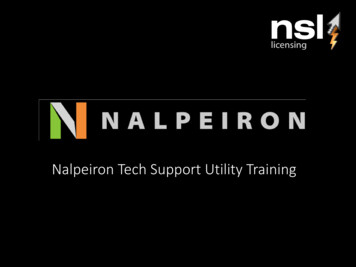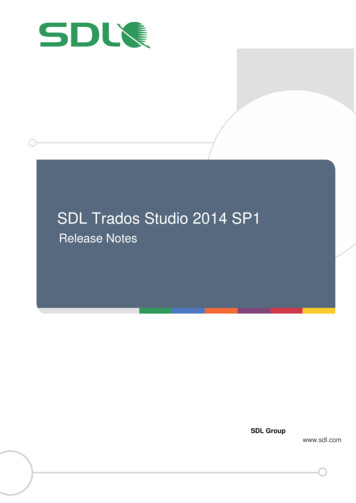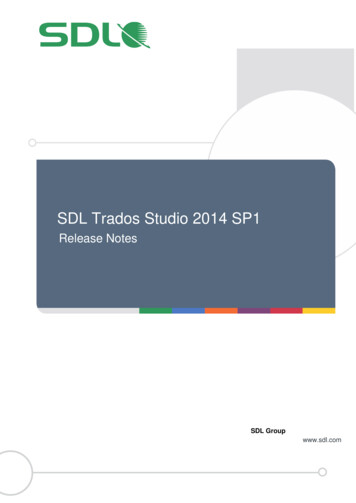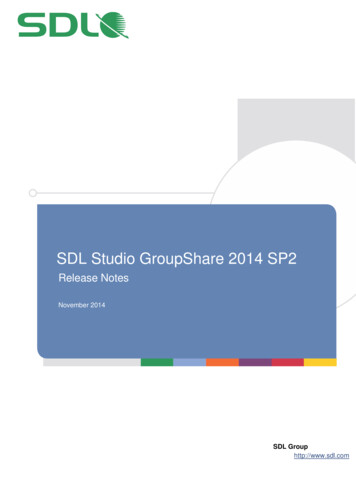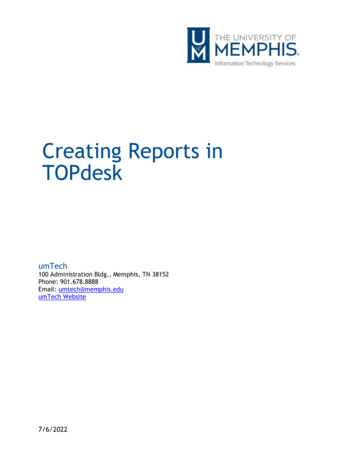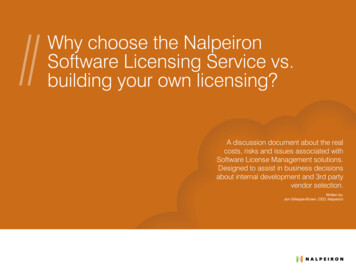
Transcription
Why choose the NalpeironSoftware Licensing Service vs.building your own licensing?A discussion document about the realcosts, risks and issues associated withSoftware License Management solutions.Designed to assist in business decisionsabout internal development and 3rd partyvendor selection.Written by:Jon Gillespie-Brown, CEO, Nalpeiron
contents3-456-7Building vs. Buying your licensingsolution, a historic look of the waypeople work and the future ofsoftware licensingQuestions to consider when decidingwhich option you’ll choose for yoursoftware license managementapproachCosts of in-house solutions are oftenhidden and not considered part ofthe vendor selection process. Exploreand reveal these costs8-91011Hosted Licensing vs home-grown inhouse licensing. Logic backed up bya survey of over 500 ISVsUsing a commercial licensing solutionand how it can meet customerdemand for more flexible licensingmodelsA clear guide of the benefits of usinga cloud-based infrastructure forsoftware licensingSources: IDC Research, Gartner Research, Software CEO and LinkedIn forums, Proformative, NetSuite, Sand Hill Group, Intacct2
Build vs. Buy?Historically many ISVs have built their own licensing due to lack offlexible or cost effective enough solutions to their needs but today withthe advent of standards such as web services and new vendors likeNalpeiron who offer a modern hosted paradigm many of those previousbarriers to outsourcing have been removed.In addition, younger CEOs are more used to running a business where many of the business functions canbe outsourced as well as the infrastructure. Everyone is well aware of the ability to offshore developmentand to use external systems like Salesforce.com, Amazon web services and EC2 but the licensing industryin general has taken time to catch up with these advances.So why has licensing lagged behind?In the past it made a great deal of sense to buildyour own licensing, often it was cheaper thanthe large up front perpetual licenses demandedby license system vendors but much moreimportantly these legacy providers did notprovide the flexibility needed to integrate within-house systems and customize the capabilityoffered to meet the needs of the ISV precisely.Today however, with the availability ofmore standards driven data interchangemethodologies like web services and moreopen APIs this is no longer the case. Plus theintroduction of competitors like Nalpeiron witha “pay as you go” model makes the wholeequation the opposite - it’s now far lower costto outsource than build in-house in real terms.Until recently ISVs had very few choices ofvendors to choose from and they all had 20 yearold business models and license managementsolutions based on older technology. However,in recent years a number of players have enteredthe market to offer the price and convenienceof Amazon and Salesforce – Nalpeiron beingthe leader in these hosted licensing solutions.Now is the time to review internal methodologiesfor licensing not only for the “shrink wrapped”and packaged software but also as a way tomigrate to more flexible SaaS type modelsfrom the older enterprise paradigm.With the move to offering end users moreflexible ways to buy and more modernlicensing options come many challenges andin-house licensing can rarely match the TCOand flexibility of outsourced solutions.Build versus buy decisions oftencome down to cost. Eitherapproach is going to require aninvestment.Oftentimes, the decision comesdown to whether it makes moresense to continue spendingmoney on maintaining ahomegrown system or outdatedproduct that isn't meeting theneed, or if investing in a thirdparty solution that meets currentand future needs is a betterapproachSource: IDC3
A License Developmentprogram comparisonMost of the research both from analysts and from real experience points tosignificant underestimation of costs and issues with licensing as whole along withan apparent shift in thinking from build your own to an outsource model.The purpose of this paper is to discuss the various licensing management system build-outoptions and their related costs, risk and benefits.It’s often tempting as a Software ISV to consider building the non-core licensing functionality yourself when lookingto control your Software assets. In many ways it appears to make sense, you are an expert in Software developmentand this is an important part of your product requirements. However, often many of the issues of building in-house areoverlooked.In particular the costs and business risks are under estimated according to Gartner. In our estimation any internaldevelopment project can cost 100-500,000 plus the yearly support costs (if you include all the staff and associated coststhat are way beyond a simple engineering effort), even for a very small ISV, and significantly more if you are a mediumor large ISV - if you include all the engineering, support, licensing, server and related support costs vs. outsourcing.One of the biggest real-life issues is keeping up with the needs of the business to be competitive and change with themarket by offering flexible sales models plus platform changes, cracks and all the related engineering updates. This canslow down the rest of the business that is relying on the internal licensing team and dramatically affects the ability torelease new products and therefore makes the ISV much less competitive in the marketplace. A big risk.Software publishers shouldconsider the entire life cycle frommanufacturing to distribution inorder to properly evaluate thedecision whether to build or buya licensing solution in its broadercontextSource: IDCAre you making a technical or business-based decision?ISVs today face profitability challenges from bothinternal and external sources. Factors such as variablemarket demand, rampant piracy, new businessmodels and increased competitive pressures causehuge stresses on a business and cost the industrybillions of dollars each year. At the same time,customers are demanding new ways of managing,understanding reporting on software licensing usage.This in turn pressurizes ISVs to offer new flexiblebusiness models such as usage, subscription andsoftware as a service to meet customer needs.4As ISVs expand globally, they may be faced withincreasing reliance on indirect channels to growtheir business. Additionally, in the face of softwarepiracy threats, it is necessary to find ways to assureand enhance revenues and better control use of theirintellectual property. ISVs need to do this all whilepreserving margins to retain more profits.Software ISVs that embed software in the productsusing hard-coded licensing terms and inflexiblepricing models have are having real difficultyresponding to these changing market demands.In summary, homegrown solutions are much moreexpensive when considering TCO than expected,they generally offer a very small feature set and aremuch “weaker” than commercial alternatives. Onthe other hand in recent years licensing vendorshave become more cost effective, offer a wider setof standard APIs and flexible licensing options and amuch lower TCO than homegrown.
Questions and considerationsIf you plan to build for the first time, do you have.Risks from internal licensing development: Internal expertise in licensing technologies? Resources for the development, testing and maintenance of licensing technologies? Expertise in integration of licensing technology with other relevant systems? Support for the technology across multiple platforms, languages and time zones? Inability to shape internal licensing to the needs of customers/newmarkets/competition Slowing the speed to market of your products Paying higher costs for a non-core activity than outsourcing Licensing staff leave preventing future improvements and changes Greater levels of losses due to piracyOther factors to consider include: Do you have the in-depth expertise to create a robust, hard to crack, system? Can you constantly update the system to defeat attacks and meet market changes? Will you adapt in-house technology in a timely manner to new licensing scenarios or to meetnew customer demands and market realities?Reasons often stated for building in-house: The ISV understands the license software as we developed it with our own team The ISV can change it if they need to and make it meet our specific needs today The solution we develop will work with our own internal business systems We don’t care about piracy or other business models so “basic” is good enoughIn the IDC report on this subject the researchhighlighted these advantages to outsourcing: Reduced cost and increased efficiencies Avoid systems that do not meet the needs of dynamic software environment Reduced cost in product fulfillment Standard infrastructure across products Faster time to market with new products Improved enforcement of software licensesSummary: Build Vs. BuyA software publisher's understanding of its core competencies withregards to building and maintaining a licensing technology platformis often a key driver in the build versus buy decision. Somepublishers may believe that since the company's core business isdeveloping software, this capability can and should be extended tosoftware-based licensing technologies. Executives at other publishersmay come to the conclusion that although developing software is acore competency, developing and maintaining a platform of licensingtechnologies is not.BuildSoftware development is acore competancyIt may be cheaper?It will work with our systemsand processesWe are too busy to changeWe can make something“good enough” for usBuy/OutsourceIt's better to focus on your coreproducts and customersIn-house is more expensiveif you include all the costsUsing a modern licensing systemoffers this and lots moreBut you could be adding 10% to your bottom lineYou could gain competitveadvantage insteadSource: IDC5
Counting the costsCosts of in-house solutions are often hidden and not considered as part of thevendor selection process. The trap many ISVs have fallen into when considering thecosts of build vs. buy is to simply underestimate the complexity or sophisticationrequired to offer the business what it really needs to compete in the market today.Oftentimes licensing projects appear muchcheaper to build in-house but get abandoned laterdue to the mounting costs of not only the build butmaintenance phases, these run into 100Ks evenfor a simple project and can take years – todayin that time a business can easily fail or a newbusiness model can emerge.models) as well as constant modification of thesolution to meet changing market dynamics (e.g.new licensing and distribution models) and piracythreats. The end result is higher initial costs andongoing maintenance expenses plus the inherentrisks of experience engineering team turnoverwithout adequate knowledge transfer.These sophisticated modern requirements meana much more complex solution than previouslyassociated with software licensing. They extendthe scope of the project to build in expected futurerequirements such as new platform and businessmodel support (think SaaS and subscriptionWhen considering whether to build or buy, youmust also take the costs of “copy protection”into account. Not only are these recurring coststhat directly impact TCO (protection mechanismsmust be constantly updated against new threats).Effective protection requires a specialized skillset that may not be readily available withinevery software vendor’s development team.Acquiring these skills in-house – either throughsupplementary training or recruitment – can beextremely costly.All of the above doesn’t include all the other costsof infrastructure, 3rd party software, training andmore.Before embarking on – or continuing – an inhouse license management system, you shouldlook beyond the startup development costs to theoverall TCO inherent in a comprehensive solution.Other forms of CostsOpportunity costs:These can be very large indeed, but very hard to easily calculate. Indeed, these are really about strategic thinking behindfocusing on core competency and growing that way rather being a “jack of all trades”. There are some easy to show hard costslike engineers dedicated to the licensing but this category should also include how well you could do if you avoided non-coreactivity that slows down the rest of the team and is a diversion from your own innovation efforts.Speed to market costs:This breaks into several areas; one is the time it takes for your own team or an outsourced one to respond to your initialrequirements and then any changes in market needs. When considering outsourcing you need to consider the on-premise vs.hosted models as relates to speed along with the initial setup times – these vary wildly and increase PS costs significantly. Foryour internal development there is not only the fact you are likely to have limited resources to make changes, they can alsoslow down the business as you wait for licensing work to complete – a big downside to competitiveness.Since adding the Nalpeironprotection we haveexperienced a 15% growthin international markets, 810% of which we attributeto having the Nalpeironprotection in place.Piracy and security costs:These relate to your markets and customers and could be very high if you are working with the consumer/international or verylow if you are mainly US enterprise focused. A look at the audience will help judge this but in general outsourced vendors havefar better technology for protection and show anywhere up to 10% revenue gains if piracy is an issue.6ThomsonReuters
Consider these costs:TCO worksheet to compare costs of various optionsCapital ExpensesBuilding OurselvesNalpeiron’s SolutionSoftware License SolutionInternal developmentcosts and supportFixed based onproduct subscriptionsSoftware Maintenance &updatesInternal developmentcosts and supportIncludedNew hardware 100K ?No costsDatabase licenses 10-100K?No costsInstallation & TrainingN/ANot requiredProject Consulting ExpensesN/ANot requiredDevelopment Costs 250-500K ?No costs for licensingBuilding OurselvesNalpeiron’s SolutionIT and Help Desk operationssupport costsHigher, not cloud basedVery lowto meet emerging security needsDesktop Management andAdministrationHigher, not cloud basedVery lowCost: Infrastructure, license fees and capital costsSoftware License ManagementHigher, not cloud basedVery lowInternal User and IT TrainingHigher, not cloud basedVery lowData center costs (Bandwidth,backup, etc) 100K ? p/yearNot requiredCost: Up-front planning to make certain that the solutiondeveloped will actually meet then organization’s needsCost: Initial development requiring years of developmentresources to create a robust, comprehensive solutionCost: Ongoing dedication of minimum two developersto maintain and update the system and respond to marketchanges, many more for larger ISVs complex requirementsCost: Training existing developers in security, or recruiting andretaining developers with these skillsCost: Continually monitoring, analyzing and creating solutionsBuild Vs. Buy - A TCO ComparisonA TCO analysis helps an organization understand and manage the many inter-relateddirect and indirect costs involved in managing and licensing a ISVs Software Assets.A thorough analysis considers not only direct costs, such as software licenses,maintenance, and required hardware, but also indirect costs, such as software assetmanagement, desktop administration and end-user support.In addition, there are many “soft” costs that need to be factored in when consideringthe licensing landscape such as revenue recovery from piracy or overuse, competitiveissues and speed to market along with simple opportunity costs from developing inhouse licensing vs. outsourcing.To compare the TCO of In-house development with Nalpeiron Licensing Service ,there are three main expense areas and additional strategic costs to be considered: Capital Expenses Operating Expenses User Management Expenses Other “soft” costsOperating ExpensesUser Management ExpensesBuilding OurselvesNalpeiron’s SolutionEnd-user Training & SupportHigher, not cloud basedVery low, easy to use,lots of offline and cloudbased optionsDowntimeHigher, not cloud based99.999% uptimeEnd user License SupportHigher, not cloud basedVery lowFixing 100K ? p/yearN/ABuilding OurselvesNalpeiron’s SolutionOpportunity costsVery highNo costsSpeed to market costsVery highNo costsPiracy and security costsVariable, 10-40% lossMake 10% revenue gainsOther forms of costsFor more detailed TCO discussions please review our whitepaper:“Total Cost of Ownership and Return on Investment model for Software Licensing”7
Hosted licensing vs.home-grown in-house licensingAccording to Nalpeiron customers, when over 500 were surveyed,these issues were the key reasons for moving away from anothervendor or away from homegrown licensing.FlexibilityImprove your speed to marketIn today’s rapidly moving Software market, being able torelease and ship products quickly and without delays to the setproject schedules are critical. We all know hitting the ship dateis a real challenge.Nalpeiron will allow you to instrument your business to offerboth older style and completely modern business models,along with the capability to analyze and change over timebased on the market requirements and competitive threats.Out sourcing non-core functions like Licensing can help decouple this critical functionality from the Software developmentprocess internally, preventing issues with delays from otherparts of the business.Reduce the business riskIn addition, if you choose a partner who offers a solutionthat is easy to integrate and fast to implement with your ownprogramming efforts, you can ship with a few extra days ofengineering time rather than months with in-house teams ormore cumbersome technologies.As well as making it easy to implement, you need somethingthat works out of the box and that uses standards to allowyou to connect all your internal systems quickly too so thatoperations don’t slow down your delivery dates.Finally, setting up the entire supporting infrastructure andtraining on it can take months with issues around servers,bandwidth, SLAs, databases and all the required connectivity.A hosted solution can eliminate all of these issues and allowyou to simply skip three to four months of delays to yourproject.8By far the most popular reason to switch out home-grownlicensing is to provide the business with far more flexibility inoffering its customers new business models, ways to buy andto make these changes fast and easy into the future.Licensing is integral to the success of your Software businessand therefore getting the right supplier to support your longterm objectives is critical to reducing risk to your business.Nalpeiron offers you the safety of an external supplier whosesole focus is on producing licensing solutions that offeryou and your users 24x7 service. We are the experts in thecomplex mix of technology, encryption, servers and platformsthat allows us to take care of your needs allowing you to focuson your core business.Our technology is battle tested with millions of users, across 8languages, 100 countries, and Win/Mac/Linux platforms. Foryears Nalpeiron has improved and refined its copy protectionand piracy protection algorithms – a capability that is farsuperior to even the largest ISV.In addition to offering expertise and resources to reduce yourrisk, we also offer an Escrow service to remove the businessrisk of outsourcing.
Built-in automated marketing tools todrive revenuesUse the power of the Nalpeiron ActiveMarketing automatedtools to increase product marketing flexibility – now you willhave real-time data and reporting, automated email marketingand the ability to push hot leads to sales - all built into theNalpeiron Licensing Service.Automatically capture revenue leakageIncrease sales by tracking license infractions and automaticallymarketing them using the Nalpeiron “overdraft” facilityThe Overdraft facility presents an automated way to “catch”users who will either deliberately or accidentally abuse yoursoftware license terms – providing you with additional salesopportunities!The Overdraft facility is a great way to expose and capturelicense abuse while offering users “softer” policing. Softerpolicing is important, especially with business customers, asit avoids many of the issues associated with software licensemanagement and it shows a level of trust to your customers.Use this unique tool to identify overuse and automaticallycapture new revenues.Hosted licensing vs.other types of solutionNalpeiron is a very flexible software platform (SaaS) that addresses ourcustomers requirements in a simple and easy to implement way.It also adds value in many ways over an old style licensing system.You probably have read about the value of adopting a modern supplier with a SaaS business model giving you allthese benefits over legacy software products offered by our competitors. In addition to all the SaaS benefits, hereare some of the reasons that customers have chosen Nalpeiron over our competitors: Nalpeiron is technically superiorIn many cases our customers simply find our platform offers a far superior technical solution to their needs.The Nalpeiron Licensing Service covers all major platforms (Win/Mac & Linux), 8 languages, an extensive API toconnect everything and totally flexible way to sell and manage your software. Nalpeiron offers a fast ROISaving engineering, operational and capital costs over an in-house or competitive solution. Nalpeiron usuallyshows ROI in months, not years. Our hosted solution also offers a transparent and cost-effective pricing plan.Using a Nalpeiron solution you will be able to instrument yourSoftware to allow you to capture, control and manage usagedata like never before. In addition, your staff will be able tocreate and produce useful reports on the way your software isconsumed, how much piracy you are suffering, what your salescycles are, who your hottest clients are, when to have salesfocus on what part of the customer base and hundreds morecritical metrics. Nalpeiron drives revenueAs well as offering the obvious means to control licenses and boost revenue that way, Nalpeiron also offers acomplete range of marketing tools that focus sales on hot leads, offer product marketing useful reporting, andallows marketing to create new sales from automated systems to tap revenue leakage and more. Nalpeiron offers a modern way to license your softwareNalpeiron offers you the choice to outsource all of the difficult and expensive infrastructure associated withlicensing. This is the modern way to run a Software ISV, allowing you to focus on your core business whileNalpeiron hosts the licensing.The opportunities to effectively plan and build a strategy arenow all at your fingertips, all in the cloud when you needthem and all easy to set up and manage by finance, sales andmarketing staff.Plus many more features and benefits.9
Why use a commercialLicensing Solution?Implementing a commercial solution can deliver a number ofimportant fiscal as well as technological advantages over ahomegrown license management solution.Software publishers should alsoconsider ongoing trends inpricing and packaging that callfor additional flexibility as well assupport for new usage scenariosand more granular packaging.A commercial solution may also offer additional, qualitative advantages over ahomegrown solution such as greater levels of security and robustness than comparablehomegrown solutions.Most homegrown solutions are very simple and lack the tools, features and options thatcontribute to greater operational efficiency.Modern hosted solutions are also set to scale, allowing vendors to grow the solutionwithout slowing the growth of the business – with a pay as you go model.Meeting customer demand for more flexible sales modelsWe all know about SaaS and other business models that are growing rapidly in the softwarespace but they are simply another business model with the same basic innovations andcustomer base traditional ISVs serve. In other words, not everyone has to switch to thenew SaaS trend to satisfy their customers - they can still happily deploy their software asan on-premise server or an installed application but they can change the basis upon whichthey charge for it.Switching business models from the older style perpetual model to usage or subscriptionbased charging has nothing to do with the delivery mechanism. With a powerful andflexible licensing system you can quickly switch your business model and entitlementsbasis without changing the rest of your operations and back end infrastructure.The IDC licensing survey also reveals an increasing demand for more flexible licensingmodels, which in turn is going to fuel the demand for more sophisticated application usagetracking tools. 22 percent of publishers currently offer usage-based pricing (up from 15percent in 2009), and over the next two years it is expected to rise to 41 percent).10Source: IDC
Benefits of cloud-basedlicense infrastructureSubscription-based pricingHigh availabilityFocus on your competencyPay as you go, on an annual basis, unlike conventionalCloud software architectures are designed from theNo need to keep up with the crackers and hackers, orsystems where you have to make a major up-frontground up for maximum network performance, so theythe constant technology changes - let Nalpeiron take theinvestment in licenses, hardware and software. You benefitfrequently deliver better application-level availability thanburden of software licensing, freeing you to focus on yourfrom better cash flow and far greater IT flexibility.conventional, on-premise solutions.core business insteadEase of access at anytime, and fromanywhereUnlimited scalabilityFlexibilityThe Nalpeiron Licensing Service has been designed to scaleYou remain much more flexible without fixed capitalCloud computing is “always on,” making it easy to growup or down and evolve according to your needs withoutcosts and unnecessary staff. No need to keep expensiveyour business and support remote workers and locations,additional infrastructure. There are virtually no limits to howresources in house for non-core functions.or support a highly mobile sales or service team, becausemany users you can have or the number of licenses thatpeople can access the cloud any time, day or night,can be activated. Nalpeiron has years of experience withLow overheadfrom any browser, desktop or mobile device. You, yourmillions of end users managed by our technology.Upgrades, maintenance and system administration takedistribution channel and your end users can all access theservice 24x7, anywhere in the world.OutsourceNo need to setup, deploy, manage or maintain licensingservers.Lower riskYou can reduce the risks of licensing staff leaving or thesystem stagnatingplace in the cloud and are managed by Nalpeiron, so youdon’t have to spend nights or weekends supervising a newversion upgrade or a failed server.Fast deploymentYou can be up and running within days, instead of months.Use the Latest Product VersionOn-demand software allows you and your end usersto enjoy the benefits of Nalpeiron’s latest features andbenefits without requiring you to worry about handling thecomplexity of software updates.Measure and report license activation andusageGet a clear picture of the products and features actuallybeing activated and used. Use captured data to generatecompetitive advantage and increase sales.11
Want to know more?Don’t hesitate. Get in touch.Toll free: 1-888-800-8818 (US only)Who’s using us?www.nalpeiron.com 1-650-799-3479 (Canada/World) 44-207-788-7843 (EMEA) 1-650-352-9046 (Fax)USAEMEANalpeiron Inc2225 E. Bayshore RoadSuite 200Palo AltoCA 94303Nalpeiron Ltd2nd Floor145-157 St John StreetLondon EC1V 4PYUKWhat is the Nalpeiron Software Licensing Service?The Nalpeiron Software Licensing Service is a comprehensive platform that enables software publishers to create a range of flexible waysto sell and market their software, with coverage for all the major platforms and the ability to choose whether to deploy software licensinginfrastructure in the cloud or on-premise. Nalpeiron is one of the strongest and most robust complete solutions on the market that supportsmillions of end users with strong but friendly ways to monetize your software.
Why choose the Nalpeiron Software Licensing Service vs. building your own licensing? A discussion document about the real costs, risks and issues associated with Software License Management solutions. Designed to assist in business decisions about internal development and 3rd party vendor selection. Written by: Jon Gillespie-Brown, CEO, Nalpeiron



